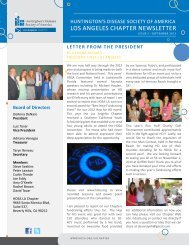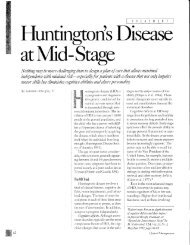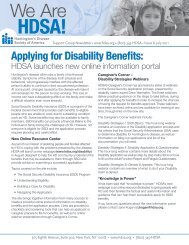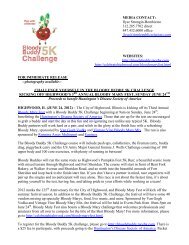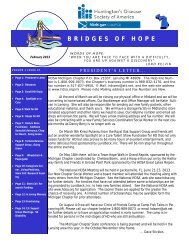Matt Bower, MS, CGC - Huntington's Disease Society of America
Matt Bower, MS, CGC - Huntington's Disease Society of America
Matt Bower, MS, CGC - Huntington's Disease Society of America
Create successful ePaper yourself
Turn your PDF publications into a flip-book with our unique Google optimized e-Paper software.
Genetics and Huntington<br />
disease<br />
<strong>Matt</strong>hew <strong>Bower</strong>, <strong>MS</strong>, <strong>CGC</strong><br />
Genetic counselor<br />
University <strong>of</strong> Minnesota Medical Center,<br />
Fairview
The information provided by speakers<br />
in workshops, forums, sharing/networking<br />
sessions and any other educational<br />
presentation made as part <strong>of</strong> the 2011 HDSA<br />
convention program is for informational use<br />
only.<br />
HDSA encourages all attendees to<br />
consult with their primary care provider,<br />
neurologist or other healthcare provider about<br />
any advice, exercise, medication, treatment,<br />
nutritional supplement or regimen that may<br />
have been mentioned as part <strong>of</strong> any<br />
presentation.
Presenter Disclosures<br />
<strong>Matt</strong>hew <strong>Bower</strong>, <strong>MS</strong><br />
The following personal financial relationships with<br />
commercial interests relevant to this presentation<br />
existed during the past 12 months:<br />
No relationships to disclose
Roadmap:<br />
• Ancient history (aka before 1993)<br />
• Mapping the HD gene<br />
• Modern history<br />
•The era <strong>of</strong> predictive testing<br />
•Life in a molecular lab<br />
•Molecular explanations for HD mysteries
HD history--Making genetics interesting!
History <strong>of</strong> HD in <strong>America</strong><br />
Huntington G. (1872) The Medical and Surgical Reporter 26(15))
What was notable about Dr.<br />
Huntington’s description?<br />
• Published when he was only 22 years old!<br />
• His only medical publication.<br />
• Drew on 78 years <strong>of</strong> records from his family’s medical practice on<br />
long island<br />
• Accurate description <strong>of</strong> the hereditary nature <strong>of</strong> the disease<br />
• Gregor Mendel had only described dominant and recessive<br />
patterns <strong>of</strong> inheritance in 1865 (using peas!)
Key points on autosomal dominant inheritance:<br />
Autosomal- Both males and females can be affected with HD.<br />
Both males and females can pass HD to their children.<br />
Dominant- If a person has Huntington disease, there is a 50%<br />
risk for each <strong>of</strong> their children.<br />
If a person does not inherit HD from their parent, they cannot<br />
pass it to their children.<br />
Each child <strong>of</strong> a person with HD has an independent 50% risk.<br />
(i.e. their risk is not changed by whether or not their brothers’<br />
or sisters’ test results).
While we understood the inheritance pattern for<br />
many years, we did not have the necessary tools<br />
to find the actual gene:<br />
• Important groundwork from the 20 th century<br />
• The discovery <strong>of</strong> DNA<br />
• Formation <strong>of</strong> patient advocacy groups<br />
• Most notably the contributions <strong>of</strong> the<br />
Wexler family.
1979- The US-Venezuela HD<br />
Collaborative Research Project<br />
Why look for genes?<br />
• Understand the mechanism <strong>of</strong> disease<br />
• Potential treatments<br />
• Answers for families<br />
• Scientific curiosity
Why Venezuela?<br />
• Lake Maracaibo region <strong>of</strong> Venezuela<br />
has the highest incidence <strong>of</strong> HD in the<br />
world.<br />
•All cases can be traced to a single<br />
European ancestor.<br />
•This founder has ~18,000 descendants.
Searching for genes- A brief detour to<br />
define genetic terms.
Where is our genetic information stored?<br />
Cell<br />
Chromosomes<br />
Nucleus
What are chromosomes ?<br />
• Packages <strong>of</strong> genetic information<br />
• We have two copies <strong>of</strong> each<br />
chromosome (one from mom and one<br />
from dad)
Ancient history <strong>of</strong> HD<br />
• Some descriptions may date back
What is a gene?<br />
• A gene is a series <strong>of</strong> genetic letters (A, C,<br />
G, T) that spells out a specific instruction<br />
for the body.<br />
• Genes encode proteins.<br />
• The Huntington disease gene tells the body<br />
how to make “Huntingtin protein”-nobody<br />
knows the function <strong>of</strong> this protein.
The HD story- finding the gene<br />
Perspective:<br />
In 2011, finding the HD gene would be a<br />
relatively simple undertaking.
The HD story- finding the gene<br />
1979<br />
• No modern scientific techniques<br />
• No human genome sequence<br />
• No catalogs <strong>of</strong> normal variants to use for<br />
mapping<br />
• No clues from the normal structure or<br />
function <strong>of</strong> the gene product.<br />
• Late age <strong>of</strong> onset- difficult to assign<br />
individuals to “Affected” or “unaffected” groups
How do you map a gene?<br />
• You need large families who are willing to<br />
be clinically evaluated and to give a blood<br />
sample.<br />
• Researchers then look for parts <strong>of</strong><br />
chromosomes that are shared by family<br />
members affected with the condition.<br />
• Conversely- exclude areas <strong>of</strong> the genome<br />
that are not shared by affected individuals.<br />
• Initial results usually highlight several areas<br />
<strong>of</strong> interest (see next slide)
HD gene<br />
location<br />
Ancient history <strong>of</strong> HD<br />
• Some descriptions may date back
What comes next?<br />
• Researchers try to hone in on which <strong>of</strong><br />
these regions actually contains the gene.<br />
• Larger families (and a little luck) are<br />
needed for more precision.<br />
• In 1983, researchers pinpoint the<br />
approximate location <strong>of</strong> the HD gene on<br />
chromosome 4.
Gene location is mapped to<br />
4p16.3<br />
Nature 306(5940); 234-238 (1983).
HD Presumed gene<br />
location <strong>of</strong><br />
the HD gene<br />
Ancient history <strong>of</strong> HD<br />
• Some descriptions may date back
The frustrating search for the<br />
gene<br />
• The gene’s approximate location was found in<br />
1983<br />
• Linkage testing could give a likelihood <strong>of</strong> being<br />
affected, but not a certainty.<br />
• The actual gene was not found until 1993<br />
• Required world-wide collaboration <strong>of</strong> scientists<br />
and families
Success!<br />
• [No authors listed]<br />
The <strong>Huntington's</strong> <strong>Disease</strong> Collaborative Research Group.<br />
• A novel gene containing a trinucleotide repeat that is expanded and<br />
unstable on <strong>Huntington's</strong> disease chromosomes. Cell. 1993 Mar<br />
26;72(6):971-83.
Success!
Discovering the HD gene<br />
• The HD gene was called “IT15”<br />
• The gene contained a repeated series <strong>of</strong><br />
letters- a CAG repeat.<br />
• Affected individuals from 75 different families<br />
consistently had > 40 CAG repeats<br />
• Unaffected individuals consistently had
Discovery <strong>of</strong> HD gene opened the door for accurate<br />
predictive testing<br />
Rather than a “probability” <strong>of</strong> being<br />
affected based on sharing genetic<br />
information, individuals received their own<br />
“CAG” repeat number
Discovery <strong>of</strong> HD gene opened the door for accurate<br />
predictive testing
Predictive Testing Guidelines<br />
Key Points- Autonomy<br />
“2. The decision to take the test is the solely choice <strong>of</strong> the<br />
individual concerned. No requests from third parties - family<br />
or otherwise - shall be considered.”<br />
“2. The individual must choose freely to be tested and must<br />
not be coerced by family, friends, partners or potential<br />
partners, physicians, insurance companies, employers,<br />
governments, or others.”<br />
Neurology (1994) 44(8) 1533-1536.<br />
Journal <strong>of</strong> Medical Genetics (1994) 31(7) 555-559
Predictive Testing Guidelines<br />
Key Points- Juveniles<br />
“2.1 The test is available only to individuals who have reached<br />
the age <strong>of</strong> majority (according to the laws <strong>of</strong> the respective<br />
country).”<br />
Neurology (1994) 44(8) 1533-1536.<br />
Journal <strong>of</strong> Medical Genetics (1994) 31(7) 555-559
Predictive Testing Guidelines<br />
Key Points- Setting<br />
“2.9 The counselors should be specifically trained in<br />
counseling methods and form part <strong>of</strong> a multidisciplinary<br />
team.”<br />
“2.9 Such multidisciplinary team should consist <strong>of</strong>, e.g.., a<br />
geneticist, a neurologist, a social worker, a psychiatrist and<br />
someone trained in medical ethical questions.”<br />
Neurology (1994) 44(8) 1533-1536.<br />
Journal <strong>of</strong> Medical Genetics (1994) 31(7) 555-559
Lessons from 15 years <strong>of</strong> predictive testing<br />
Uptake <strong>of</strong> predictive genetic testing– What percentage <strong>of</strong><br />
the “at-risk” population chooses to have predictive genetic<br />
testing.<br />
• Prior to the availability <strong>of</strong> predictive testing, 60-85% <strong>of</strong> atrisk<br />
individuals said they would use a predictive test.<br />
•Large study <strong>of</strong> Canadian experience reflected worldwide<br />
trends that only 10-20% <strong>of</strong> at-risk individuals have chosen to<br />
have predictive testing.<br />
Creighton et al (2003) Clinical Genetics 63(6) 462-475.
Lessons from 15 years <strong>of</strong> predictive testing<br />
Who uses predictive testing?–<br />
• Females tend to outnumber males 2:1<br />
• Average age in two studies (37-39)<br />
Creighton et al (2003) Clinical Genetics 63(6) 462-475.
Life in a Molecular Diagnostics Lab
My life in a Molecular Diagnostics Lab
Life in a Molecular Lab<br />
• The molecular lab at the University <strong>of</strong><br />
Minnesota performs testing for hospitals<br />
throughout the country<br />
• >4000 tests have been performed since the<br />
1990’s.
Receiving the sample<br />
• Most <strong>of</strong> our testing is done with blood<br />
samples.<br />
• We occasionally test other tissue from<br />
autopsy (skin, brain).<br />
• Testing can be performed on any tissue<br />
containing DNA (no hair or<br />
fingernails…sorry CSI fans).
Receiving the sample<br />
• One <strong>of</strong> the most important steps is<br />
identification <strong>of</strong> the sample.<br />
• 2 identifiers must be matched-usually<br />
name and date <strong>of</strong> birth.<br />
• Samples are assigned a unique number<br />
which is used to track it through the testing<br />
process.
Cell Lysis- A controlled explosion!<br />
Before lysis<br />
After lysis
DNA precipitation-<br />
DNA is “pulled out” <strong>of</strong> the solution by using alcohol
CAGx17<br />
CAGx40<br />
Question- How can we visualize 2 tiny pieces<br />
<strong>of</strong> DNA?<br />
Answer-Make millions <strong>of</strong> fluorescent copies!
PCR- molecular “xeroxing”<br />
Fluorescent primers<br />
CAGx17<br />
CAGx40
PCR-Molecular Xeroxing
15<br />
20<br />
15 and 20 CAG<br />
repeats<br />
17<br />
63<br />
17 and 63 CAG<br />
repeats
Identifying information
Technical results-<br />
“CAG” repeat numbers
Interpretation- what does the<br />
technical result mean for the patient?
Official repeat ranges for HD<br />
• 9-26 repeats= Normal<br />
• No risk for HD and no known risk to children.<br />
• 27-35 repeats=Intermediate<br />
• No risk for HD, but a small risk to children<br />
•36-39 repeats=Reduced penetrance<br />
• May develop HD and a 50% risk to children<br />
•40+ repeats=Full penetrance<br />
• Will develop HD and a 50% risk to children<br />
Potter et al. (2004) Genetics in Medicine 6(1) 61-65.<br />
ASHG (1998) <strong>America</strong>n Journal <strong>of</strong> Human Genetics 62(5) 1243-1247.
Discovery <strong>of</strong> HD gene answers many <strong>of</strong> the<br />
“mysteries” <strong>of</strong> HD<br />
• Anticipation- The observation that the age <strong>of</strong> onset<br />
becomes consistently younger in some families<br />
• Prior to the discovery <strong>of</strong> CAG repeats, many<br />
scientists discounted this observation and<br />
attributed it to “hyper-awareness” <strong>of</strong> families and<br />
physicians.
Diagnosis-65<br />
Diagnosis-40<br />
Diagnosis-45<br />
Diagnosis-25<br />
Juvenile HD
CAG repeats explain<br />
anticipation<br />
Diagnosis-65<br />
17,40<br />
Diagnosis-40<br />
17,44 17,44<br />
Diagnosis-25<br />
17,50<br />
Juvenile HD<br />
17,68
Anticipation is due to expansion <strong>of</strong> CAG repeats<br />
• CAG repeat numbers can expand when<br />
passed to <strong>of</strong>fspring.<br />
• Expansion occurs more <strong>of</strong>ten with male<br />
transmission.<br />
• Expansion occurs more with larger repeat<br />
numbers.<br />
• Some genes are more stable than others
HD without a family historyas<br />
many as 20% <strong>of</strong> cases<br />
HD-Diagnosed<br />
age 45
HD without a family history<br />
A molecular explanation:<br />
•Expansion <strong>of</strong> an intermediate repeat number<br />
16, 35 17,18<br />
42, 18
HD “skips generations”<br />
Died age 85-HD<br />
Died 76-No HD<br />
HD diagnosed age 44
HD “skips generations”<br />
Died age 85-HD<br />
17,37<br />
Died 76-No HD<br />
17,37<br />
17,42<br />
HD diagnosed age 44<br />
A “Reduced<br />
penetrance” mutation<br />
explains this family<br />
history



